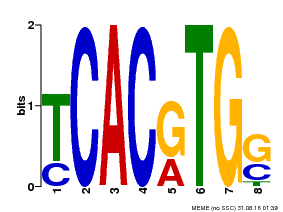- Skinner MK,Rawls A,Wilson-Rawls J,Roalson EH
Basic helix-loop-helix transcription factor gene family phylogenetics and nomenclature.
Differentiation, 2010. 80(1): p. 1-8
[PMID:20219281] - Carabelli M,Turchi L,Ruzza V,Morelli G,Ruberti I
Homeodomain-Leucine Zipper II family of transcription factors to the limelight: central regulators of plant development.
Plant Signal Behav, 2014.
[PMID:23838958] - Karayekov E,Sellaro R,Legris M,Yanovsky MJ,Casal JJ
Heat shock-induced fluctuations in clock and light signaling enhance phytochrome B-mediated Arabidopsis deetiolation.
Plant Cell, 2013. 25(8): p. 2892-906
[PMID:23933882] - Mannen K, et al.
Coordinated transcriptional regulation of isopentenyl diphosphate biosynthetic pathway enzymes in plastids by phytochrome-interacting factor 5.
Biochem. Biophys. Res. Commun., 2014. 443(2): p. 768-74
[PMID:24342623] - Ding Y, et al.
Four distinct types of dehydration stress memory genes in Arabidopsis thaliana.
BMC Plant Biol., 2013. 13: p. 229
[PMID:24377444] - Di C, et al.
Characterization of stress-responsive lncRNAs in Arabidopsis thaliana by integrating expression, epigenetic and structural features.
Plant J., 2014. 80(5): p. 848-61
[PMID:25256571] - Dornbusch T,Michaud O,Xenarios I,Fankhauser C
Differentially phased leaf growth and movements in Arabidopsis depend on coordinated circadian and light regulation.
Plant Cell, 2014. 26(10): p. 3911-21
[PMID:25281688] - Seaton DD, et al.
Linked circadian outputs control elongation growth and flowering in response to photoperiod and temperature.
Mol. Syst. Biol., 2015. 11(1): p. 776
[PMID:25600997] - Filo J, et al.
Gibberellin driven growth in elf3 mutants requires PIF4 and PIF5.
Plant Signal Behav, 2015. 10(3): p. e992707
[PMID:25738547] - Mizuno T,Oka H,Yoshimura F,Ishida K,Yamashino T
Insight into the mechanism of end-of-day far-red light (EODFR)-induced shade avoidance responses in Arabidopsis thaliana.
Biosci. Biotechnol. Biochem., 2015. 79(12): p. 1987-94
[PMID:26193333] - Galvão VC,Collani S,Horrer D,Schmid M
Gibberellic acid signaling is required for ambient temperature-mediated induction of flowering in Arabidopsis thaliana.
Plant J., 2015. 84(5): p. 949-62
[PMID:26466761] - Miyazaki Y, et al.
Enhancement of hypocotyl elongation by LOV KELCH PROTEIN2 production is mediated by auxin and phytochrome-interacting factors in Arabidopsis thaliana.
Plant Cell Rep., 2016. 35(2): p. 455-67
[PMID:26601822] - Yue J, et al.
TOPP4 Regulates the Stability of PHYTOCHROME INTERACTING FACTOR5 during Photomorphogenesis in Arabidopsis.
Plant Physiol., 2016. 170(3): p. 1381-97
[PMID:26704640] - Pacín M,Semmoloni M,Legris M,Finlayson SA,Casal JJ
Convergence of CONSTITUTIVE PHOTOMORPHOGENESIS 1 and PHYTOCHROME INTERACTING FACTOR signalling during shade avoidance.
New Phytol., 2016. 211(3): p. 967-79
[PMID:27105120] - Fernández V,Takahashi Y,Le Gourrierec J,Coupland G
Photoperiodic and thermosensory pathways interact through CONSTANS to promote flowering at high temperature under short days.
Plant J., 2016. 86(5): p. 426-40
[PMID:27117775] - Martin G,Soy J,Monte E
Genomic Analysis Reveals Contrasting PIFq Contribution to Diurnal Rhythmic Gene Expression in PIF-Induced and -Repressed Genes.
Front Plant Sci, 2016. 7: p. 962
[PMID:27458465] - Gray JA,Shalit-Kaneh A,Chu DN,Hsu PY,Harmer SL
The REVEILLE Clock Genes Inhibit Growth of Juvenile and Adult Plants by Control of Cell Size.
Plant Physiol., 2017. 173(4): p. 2308-2322
[PMID:28254761] - Kasulin L, et al.
A single haplotype hyposensitive to light and requiring strong vernalization dominates Arabidopsis thaliana populations in Patagonia, Argentina.
Mol. Ecol., 2017. 26(13): p. 3389-3404
[PMID:28316114] - Wei Z, et al.
Brassinosteroid Biosynthesis Is Modulated via a Transcription Factor Cascade of COG1, PIF4, and PIF5.
Plant Physiol., 2017. 174(2): p. 1260-1273
[PMID:28438793] - Shor E,Paik I,Kangisser S,Green R,Huq E
PHYTOCHROME INTERACTING FACTORS mediate metabolic control of the circadian system in Arabidopsis.
New Phytol., 2017. 215(1): p. 217-228
[PMID:28440582] - Paik I,Kathare PK,Kim JI,Huq E
Expanding Roles of PIFs in Signal Integration from Multiple Processes.
Mol Plant, 2017. 10(8): p. 1035-1046
[PMID:28711729] - Swain S,Jiang HW,Hsieh HL
FAR-RED INSENSITIVE 219/JAR1 Contributes to Shade Avoidance Responses of Arabidopsis Seedlings by Modulating Key Shade Signaling Components.
Front Plant Sci, 2017. 8: p. 1901
[PMID:29163619]
|





